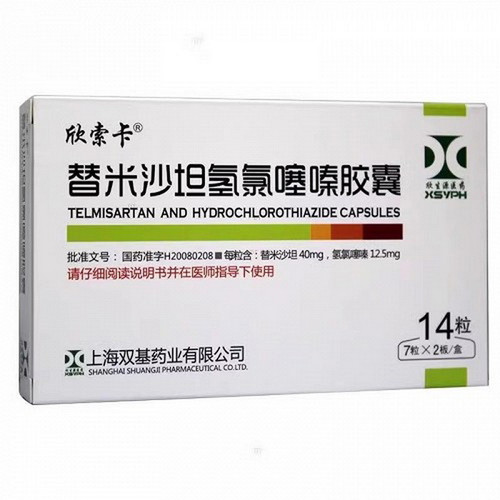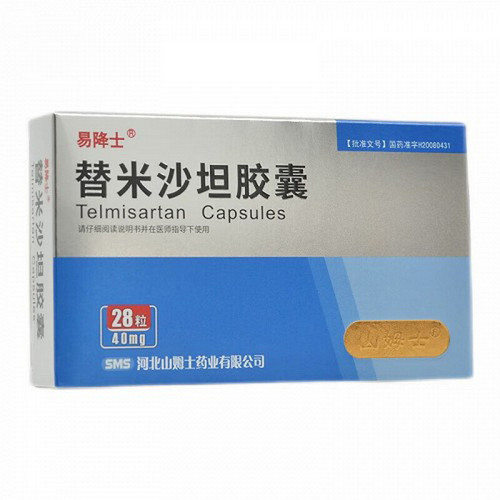Product Overview
[Generic Name]
Telmisartan Capsules
[Trade Name]
Zhixinfeng
[English Name]
Telmisartan Capsules
[Chinese Pinyin]
Timishatan Jiaonang
[Ingredients]
4'-[(2-n-propyl-4-methyl-6-(1-methylbenzimidazol-2-yl)-benzimidazol-1-yl)methyl]diphenyl-2-carboxylic acid = Telmisartan
[Properties]
This product is a hard capsule containing white or slightly yellow granules or powder.
[Indications]
For the treatment of essential hypertension.
[Dosage and Administration]
1. Adults: Dosage should be individualized. The usual initial dose is one 40 mg capsule once daily. Within the 20-80 mg dose range, the antihypertensive effect of telmisartan is dose-dependent. If optimal blood pressure is not achieved after treatment, the dose may be increased, up to a maximum of 80 mg (two capsules) once daily. This product can be used in combination with thiazide diuretics, such as hydrochlorothiazide, which have a synergistic antihypertensive effect. Because telmisartan does not reach its maximum effect until four to eight weeks after the start of treatment, this should be considered when increasing the dose. 2. Patients with renal impairment, including mild or moderate renal impairment, do not require dose adjustment. Telmisartan cannot be eliminated by hemodialysis. 3. Patients with mild or moderate hepatic impairment, do not exceed 40 mg per day. 4. Elderly: No dose adjustment is required. 5. Children: Safety and efficacy data for this product have not been established in children and adolescents under 18 years of age.
[Adverse Reactions]
Diarrhea is a possible adverse reaction to this product, similar to other angiotensin II antagonists. Angioedema, pruritus, rash, and urticaria have been reported in rare cases.
[Contraindications]
1. Hypersensitivity to the active ingredient or any of the excipients of this product. 2. Second- to third-trimester pregnancy and breastfeeding women. 3. Patients with biliary obstructive disease. 4. Patients with severe hepatic insufficiency. 5. Patients with severe renal insufficiency (creatinine clearance 30 ml/min).
[Precautions]
1. Hepatic Insufficiency: This product should not be used in patients with cholestasis, biliary obstructive disease, or severe hepatic dysfunction, as telmisartan is largely excreted via bile, and clearance of this product may be reduced in these patients. This product should be used with caution in patients with mild to moderate hepatic insufficiency. 2. Renovascular Hypertension: In patients with bilateral renal artery stenosis or unilateral renal artery stenosis, the risk of severe hypotension and renal insufficiency may be increased with the use of medications that affect the renin-angiotensin-aldosterone system. 3. Renal Insufficiency and Renal Transplant Patients: This product should not be used in patients with severe renal insufficiency (creatinine clearance 30 ml/min, see Contraindications). For patients with renal insufficiency, serum potassium and creatinine levels should be monitored regularly while using this product. There are no data on the use of this product in patients shortly after a recent renal transplant. 4. Patients with Hypovolemia: For patients with hypovolemia or low serum sodium levels due to strong diuretic therapy, salt restriction, nausea, or vomiting, the use of this product, especially after the first dose, may cause symptomatic hypotension. Therefore, serum sodium and volume levels should be corrected before using this product. 5. Other Conditions Related to Stimulation of the Renin-Angiotensin-Aldosterone System: For patients whose vascular tone and renal function are primarily dependent on the activity of the renin-angiotensin-aldosterone system (such as those with severe congestive heart failure or underlying renal disease including renal artery stenosis), the use of drugs that affect this system may cause acute hypotension, hyperazotemia, oliguria, or rarely, acute renal failure. 6. Primary Aldosteronism: Antihypertensive drugs that inhibit the renin-angiotensin-aldosterone system are generally ineffective in patients with primary aldosteronism, so this product is not recommended for use in these patients. 7. Aortic or mitral stenosis, obstructive hypertrophic cardiomyopathy: As with other vasodilators, this product should be used with caution in patients with aortic or mitral stenosis, or obstructive hypertrophic cardiomyopathy. 8. Electrolyte Imbalance: Hyperkalemia may be caused by the use of drugs that affect the renin-angiotensin-aldosterone system, especially in patients with renal impairment and/or heart failure, and diabetes. For patients at risk, serum potassium levels should be closely monitored while taking this product. Based on experience with other drugs that affect the renin-angiotensin system, co-administration of this product with potassium-sparing diuretics, potassium supplements, potassium-containing salt substitutes, or other drugs that increase serum potassium levels (such as heparin) may increase serum potassium levels. Therefore, caution should be exercised when using this product with other drugs that affect the renin-angiotensin system (see Drug Interactions). 9. Other: Similar to angiotensin-converting enzyme inhibitors, the antihypertensive effect of this drug and other angiotensin receptor blockers is lower in blacks than in other ethnic groups. This may be related to the higher prevalence of low renal cord in hypertensive individuals in blacks. As with other antihypertensive drugs, excessive blood pressure reduction can cause myocardial infarction or stroke in patients with ischemic heart disease or ischemic cardiovascular disease. 10. Effects on Driving and Operating Machinery: The effects of this drug on driving and operating machinery have not been studied. However, caution is advised when driving or operating machinery, as antihypertensive treatment can sometimes cause dizziness and drowsiness.
[Precautions for Children]
Safety and efficacy data for this drug have not been established for children and adolescents under 18 years of age.
[Precautions for Pregnancy and Lactation]
1. Use During Pregnancy: Insufficient data exist to indicate whether this drug is suitable for use in pregnant women. Animal studies have not shown teratogenicity, but have shown embryotoxicity. Therefore, as a precaution, telmisartan should not be used in the first two months of pregnancy. Appropriate alternative treatments should be considered before attempting pregnancy. During the second and third trimesters of pregnancy (during the second and third trimesters), drugs that directly act on the renin-angiotensin system can cause fetal harm or even death. Therefore, telmisartan is contraindicated. Once pregnancy is confirmed, this drug should be discontinued as soon as possible. 2. Use during Breastfeeding: Since it is unknown whether this drug is excreted in breast milk, this drug is contraindicated during breastfeeding.
[Precautions for Elderly Persons]
No dose adjustment is required for this drug.
[Drug Interactions]
1. Lithium: Concomitant use of lithium with angiotensin-converting enzyme inhibitors can cause reversible increases in blood lithium levels and toxic reactions. There have also been isolated cases of this condition caused by the concomitant use of lithium with angiotensin II receptor antagonists. Therefore, caution is advised when using lithium with this drug. If combined use is necessary, blood lithium levels should be monitored during this period. 2. Some medications can affect serum potassium levels or cause hyperkalemia (such as ACE inhibitors, potassium-sparing diuretics, potassium supplements, potassium-containing salt substitutes, cyclosporine A, or other medications such as heparin sodium); if this product is used concomitantly with these medications, it is recommended to monitor serum potassium levels. Based on experience with other medications that affect the renin-angiotensin system, concomitant use of this product with these medications may increase serum potassium levels (see Precautions). 3. Pharmacokinetic studies have investigated the interaction of this product with digoxin, warfarin, hydrochlorothiazide, glyburide, ibuprofen, paracetamol, amlodipine, and other medications. Digoxin plasma concentrations may increase by 20% (in some cases by 39%), so clinical monitoring of digoxin plasma concentrations is necessary. 4. This product may enhance the antihypertensive effect of other antihypertensive medications. Other clinically significant interactions have not been confirmed. 5. Based on their pharmacological properties, the following medications may enhance the antihypertensive effect of antihypertensive medications, including telmisartan: baclofen and amifostine. In addition, alcohol, barbiturates, sedatives, hypnotics, or antidepressants may potentiate the orthostatic hypotensive effect. 6. When coadministered with telmisartan, the Cmax of simvastatin metabolites (simvastatin acid) was slightly increased (1.34-fold) and its elimination was accelerated.
[Pharmacological Actions]
Pharmacological Properties: Telmisartan is an orally active, specific angiotensin II receptor (AT1) antagonist. Telmisartan displaces angiotensin II receptors and binds with high affinity to the AT1 receptor subtype (the known site of angiotensin II action). Telmisartan does not exhibit any partial agonist effect at the AT1 receptor site. Telmisartan selectively binds to the AT1 receptor, and this binding is long-lasting. Telmisartan has no affinity for other receptors, including AT2 and other less well-characterized AT receptors. The functions of these other receptors are unknown, and the potential for receptor overstimulation due to increased angiotensin II levels caused by telmisartan is also unknown. Telmisartan can cause a decrease in blood aldosterone levels. Telmisartan does not inhibit plasma renin or block ion channels in humans. Telmisartan does not inhibit angiotensin-converting enzyme (AKT) II, which also degrades bradykinin, and therefore does not cause adverse reactions due to enhanced bradykinin action. In humans, administration of 80 mg of telmisartan almost completely inhibits the angiotensin II-induced increase in blood pressure. This inhibitory effect persists for 24 hours and is still measurable after 48 hours. The antihypertensive effect becomes increasingly evident within 3 hours after the first dose of telmisartan. Maximum antihypertensive effect is achieved within four weeks of treatment and is maintained with long-term treatment. Ambulatory blood pressure monitoring demonstrates that the antihypertensive effect persists for more than 24 hours after dosing, including the four hours before the next dose. This finding was confirmed in placebo-controlled clinical trials: the trough-to-peak ratio remained above 80% after 40 and 80 mg of telmisartan. There is a clear dose-time dependence for return to baseline SBP. Data regarding DBP are conflicting in this regard. In patients with hypertension, telmisartan lowers systolic and diastolic blood pressure without affecting pulse rate. Telmisartan's antihypertensive effects are comparable to those of other representative antihypertensive drugs. (Clinical studies have compared telmisartan with amlodipine, atenolol, enalapril, hydrochlorothiazide, losartan, and lisinopril.) If telmisartan treatment is abruptly discontinued, blood pressure gradually returns to pre-treatment levels over several days without rebound hypertension. In a direct clinical trial comparing two antihypertensive drugs, the incidence of dry cough was significantly lower in patients treated with telmisartan compared with those treated with angiotensin-converting enzyme inhibitors. The effect of telmisartan on mortality and cardiovascular morbidity is currently unknown. Toxicology: At doses used in preclinical safety studies, which are comparable to clinically effective doses, telmisartan caused decreases in red blood cell indices (erythrocytes, hemoglobin, and hematocrit), altered renal hemodynamics (increased blood urea nitrogen and creatinine), and increased serum potassium in normotensive animals. Renal tubular dilation and atrophy have been observed in dogs. Gastrointestinal mucosal damage (erosions, ulcers, and inflammation) has also been observed in rats and dogs. These adverse pharmacological reactions are common to both angiotensin-converting enzyme inhibitors and angiotensin II antagonists in preclinical studies and can be prevented with oral salt supplementation. Increased plasma renin activity and juxtaglomerular cell hypertrophy/proliferation have been observed in both species. These changes are also common to angiotensin-converting enzyme inhibitors and other angiotensin II antagonists and are not clinically specific. Animal studies have shown that telmisartan has some potential adverse effects on neonatal development, including weight loss, delayed eye opening, and increased mortality. In vitro studies have not demonstrated mutagenicity or related mutagenic activity, and no carcinogenicity has been observed in studies in mice and rats.
Storage: Store in a dry place at room temperature.
Strength: 40 mg
Packaging: 40 mg x 14 s per box
Shelf life: 24 months
Approval number: National Medicine Standard H20051190
Company name: Changzhou Pharmaceutical Factory Co., Ltd.






